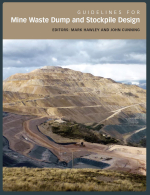Добрый день, Коллеги. Важное сообщение, просьба принять участие. Музей Ферсмана ищет помощь для реставрационных работ в помещении. Подробности по ссылке
Guidelines for mine waste dump and stockpile design / Руководство по проектированию хвостохранилищ и отвалов
In terms of both volume and mass, waste dumps associated with large open pit mines are arguably the largest manmade structures on Earth. Their footprints typically exceed the aerial extent and their heights often rival the depths of the open pits from which the material used to construct them is derived.
Figure 1.1 is a view of the East Dump at the Antamina Mine in Peru. This dump contains ~1 billion tonnes of material, covers an area of 240 ha, and has an overall height of more than 500 m. Figure 1.2 is a view of the waste dumps at Rio Tinto Kennecott’s Bingham Canyon ine in Utah, USA. This mine has a long development history spanning more than 100 years. The original dumps were constructed using rail haulage and tips, with subsequent expansions using truck haulage. Figure 1.3 is a view of a waste dump at a coal mine in the Elk Valley region of British Columbia, Canada. A cumulative volume of waste rock of over 8.5 billion tonnes with overall dump heights of up to 400 m have been deposited in the Elk Valley area coal mines over ~45 years.
While most waste dumps worldwide have performed very well, there are many cases where they have been subject to large-scale instabilities with significant adverse consequences. Figure 1.4 illustrates one such failure that occurred in 1987 at the Quintette Coal Mine in British Columbia, Canada. This failure involved more than 5.6 million m3 of material, and the runout distance exceeded 2 km (for additional details on this failure see BCMEM record #60 in Appendix 1). <...>




